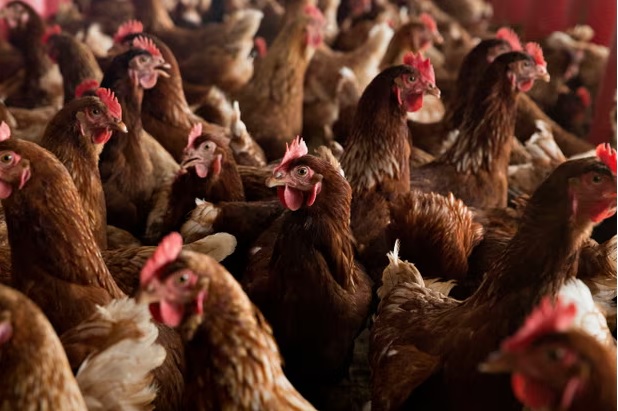Due to extreme heat in America, agricultural workers are having difficulty wearing PPE. The country is now facing its biggest human outbreak

Summer weather across much of the US may have contributed to the rise in bird flu cases. Photo: Daniel Aaker/Bloomberg via Getty Images
Extreme heat may be a key factor behind the largest bird flu outbreak in humans in the U.S., as officials continue tracking the spread of the virus.
A heatwave in Colorado possibly caused personal protective equipment for workers slaughtering chickens infected with a highly pathogenic bird flu called H5N1 to not function properly. Four people have tested positive for H5N1, and a fifth is expected to be confirmed with bird flu, officials said this week.
This is the first time multiple human cases of bird flu have been reported in the U.S.
On dairy farms, too, it has been difficult for workers to wear PPE, partly because heat is raging across much of the U.S. A case of bird flu was confirmed in a dairy worker in Colorado earlier this month.
Experts say climate change, which has been linked to extreme heat across the country, could exacerbate outbreaks of deadly diseases like these. Climate change is also linked to the emergence and wider spread of pathogens like these, including new migratory patterns for wild birds infected with H5N1. “When you alter a global system like the climate so profoundly, small changes can have seismic effects, sometimes in unexpected ways,” said Alexandra Phelan, an associate professor at the Johns Hopkins Bloomberg School of Public Health.
In Colorado, workers were killing flocks of egg-laying hens that had tested positive for H5N1.
They would round up the birds one by one, put them in a cart and kill a few dozen birds at a time with carbon dioxide gas.
“It’s a very difficult, painstaking process,” Julie Gauthier of the Animal and Plant Health Inspection Service at the U.S. Department of Agriculture (USDA) said at a press briefing on Tuesday.
And it can be dangerous to work so close and for long periods of time with animals infected with bird flu, which has a mortality rate of about 50% in people.
It was 104F (40C) outside, but in the hen houses, it was even hotter.
Amid huge industrial fans to block sweat and high temperatures, workers couldn’t keep their goggles and masks sealed to their faces, Nirav Shah, principal deputy director of the U.S. Centers for Disease Control and Prevention (CDC), told reporters. Fans also spread feathers and debris, which can carry the virus aloft, Shah said.
Of the 160 people who worked on the farm, 60 developed symptoms and five tested positive or are presumed to be positive. The remaining 55 workers tested negative for H5N1 at the Colorado State Health Laboratory and some of them were diagnosed with other respiratory illnesses. Only symptomatic workers were tested.
“As the epidemiological investigation progresses, it is important to note that additional cases may be detected,” Shah said.
At the briefing, Eric Deeble, acting senior adviser for H5N1 response at the USDA, said workers would continue to cull chickens, which make up a flock of 1.8 million birds, over the next 10 to 14 days.
“USDA considers it very important to continue population reduction to prevent amplification and shedding of the virus, prevent further spread, and reduce viral load in the environment,” Deeble said. “Even if the population decline is halted, workers will still need to care for and feed the animals, increasing their exposure to risk.”
People involved in culling chickens on the farm—iincluding poultry producers, employees, contractors, and USDA workers—aare required to wear Tyvek suits, N95 respirators, goggles, boots, and gloves when working with infected chickens.
Upon discovering the possible cases in people, Colorado immediately alerted the CDC, which sent a team of 10 experts, including an industrial hygienist, to work on procedures to minimize exposure for workers when handling infected chickens, Shah said.
Shah said the CDC and the state of Colorado “remained interconnected”—unlike other outbreaks at farms across the country, where the CDC generally had limited access to affected animals and people.
The poultry operation is in the same county as the dairy herds that tested positive for bird flu.
Genomic sequencing shows these cases are closely related to outbreaks in dairy cows. It appears to have spread from cows to chickens and then to people, though it’s not yet clear how. A USDA report from Michigan last month found the virus may have been transmitted by people between farms.
Climate change can negatively affect human health, making people more vulnerable to extreme weather and similar events, and it alters animal interactions and migration patterns that could lead to greater spread.
In fact, it may have been responsible for the H5N1 outbreak in the US.
In late 2021, wild birds carrying the virus managed to fly from northern Europe to Iceland and then to Newfoundland.
“One of the reasons this happened was unusually strong winds,” said Jean-Pierre Vaillancourt, a professor of veterinary medicine at the University of Montreal. It’s “very unusual” for birds to be able to travel so far, “but when it happened, we had really unusual climate conditions,” he said.
“It’s not just extreme heat. It’s the fact that you have unusual climate events,” Vaillancourt said. “This can disrupt normal migratory patterns” and other human and animal behaviors, opening up new avenues of exposure.
These are the first cases among US poultry workers since 2022, when a prisoner tested positive after slaughtering infected chickens in Colorado.
Shah said five workers in 2024 reported more common flu symptoms such as conjunctivitis (or “pink eye”) and teary eyes, as well as fever, chills, cough, and sore throat. None of them required hospitalization, and all are recovering, he said.
The CDC has not changed its risk assessment for the general public or its policies for addressing farm outbreaks, including recommendations on vaccines.
“CDC is not recommending an H5-specific vaccine for livestock workers because of the mild symptoms seen so far, in the absence of any change in the genetic makeup of the virus,” Shah said.
Vaccines for cows are also being studied.
“We are confident we can eliminate it within dairy herds,” Deeble said.
“Increased biosecurity will get us to the point where we can stop the spread, and hopefully in the future, we can get a vaccine that can further help eliminate this disease from the national herds,” he said. Phelan said authorities must put climate considerations at the forefront of tackling and potentially eradicating such viruses. “Across all sectors, governments need to actively and urgently incorporate climate considerations into all health and safety measures, not just at a superficial level.”
Ideas and sources:-www.theguardian.com




